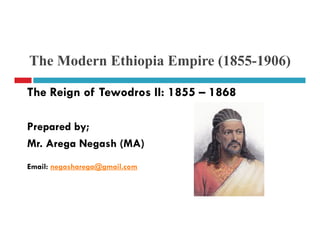Modern ethiopia empire and the reign of tewodros II
- 1. The Modern Ethiopia Empire (1855-1906) TThehe ReignReign ofof TewodrosTewodros IIII:: 18551855 ŌĆōŌĆō 18681868 PreparedPrepared byby;;PreparedPrepared byby;; MrMr.. AregaArega NegashNegash (MA(MA)) Email: negasharega@gmail.com
- 2. The Modern Ethiopia Empire TThehe ReignReign ofof TewodrosTewodros IIII:: 18551855 ŌĆōŌĆō 18681868 Attempts at reunification Before the coming of Tewodros II to Power-Before the coming of Tewodros II to Power- there was power struggle between warlords. In Ethiopia history, this period was - known by the period of ŌĆśŌĆśZemene MesafintŌĆÖŌĆÖ or some times the ŌĆśŌĆśEra of warlordsŌĆÖŌĆÖ from 1769- 1855.
- 3. The Zemene MesafintŌĆ” ’ā╝ The regional power conflicts: among various objectives, the war lords fought mainly for the Title of ŌĆśŌĆśRas BitweddeŌĆÖŌĆÖ to become king maker. ’ā╝ The central authority lost their supreme power 3 ’ā╝ The central authority lost their supreme power ’ā╝ Almost all the regions were semi- autonomous ’ā╝ Period for political fragmentation, civil war, social and economic disorder ’ā╝ Affected the social and economic life of the peasantry ’ā╝ The crisis came to an end after Tewodros II crowned Emperor of Ethiopia in 1855
- 4. Early 1850ŌĆÖs, Kass Hailu before crowned as Emperor Tewodros II he scored remarkable victory over different regional lords. Political Reunification 4 regional lords. Emperor Tewodros II dreamt of restoring imperial power: Building political reunification and eliminate the regional power struggle.
- 5. Tewodros II: realized the use of force to bring regional lords under control The Military expedition: ’ü▒ First: against the region of Wollo - unsuccessful 5 First: against the region of Wollo - unsuccessful ’ü▒ The second campaign was to Showa - faced a bloody encounter ’ā╝ The battle of Baraket, 1855 ’ā╝ Hailemelekot of Showa defeated by the imperial army. ’ü▒ The Emperor went on subduing one region after another through protracted and punitive military expeditions.
- 6. The Emperor had the ambition to introduce modernization and European technology to the country. Reforms: Tewodros II attempted lots of reforms Modernization 6 1. socio- economy reforms Abolished slavery, banditry and looting of peasants. Tried to stop polygamy. 2. Religious reforms Tried to stop divisions of church and declared Orthodox Tewahido as state religion. Reduced the number of priests and deacon in church to 2 and 3 respectively. Taking away the church land and distributed to peasants to collect tax.
- 7. ’āś Introduced national and modern salaried army ’āś He gave much emphasis to build modern military technology and arms manufacturing. Evidently he build small military/canon workshop at Gafat. Military reformsMilitary reforms 7 ’āś Evidently he build small military/canon workshop at Gafat. Internal Oppositions to Tewodros II ’āśThe internal enemy of the Emperor were the regional lords and clargy. ’āśThe his reunification attempts treated the power of the lords. ’āśHis policy on church land brought the emperor direct into church-state conflict.
- 8. Tewodros wanted to import the technical skilled men for arms manufactruing locally. Sent various letters to British in order to get skilled personnel. When his efforts turned fruitless, He gathered and imprisoned all European missionaries living in the country. He then forced them to build arms locally. External challengesExternal challenges 8 missionaries living in the country. He then forced them to build arms locally. They manufactured the first local canon called Sepastopol as Gafat. Sepastopol
- 9. The Battle of Maqdala, 1868 9 ’ü▒ The captivity of European however provoked anxiety, especially in Britain. The British Government asked to release the missionaries, but Tewodros gave deaf ear. ’ü▒ The British sent 10,000 expedition force led by Robert Napier to Maqdala, 1867. The first and last major encounter between the British and ethiopian Imperial’é© The first and last major encounter between the British and ethiopian Imperial army took place at Eroge in April 1868 before the battle of Maqdala. ’é© The British force defeated Fitawerari Gebrey who was the right hand of the Emperor. ’é© The event hastened the downfall of Tewodros. ’é© At Maqdala, on 13 April 1868, Tewodros comitted sucicide rather than surrender by foreign force.









